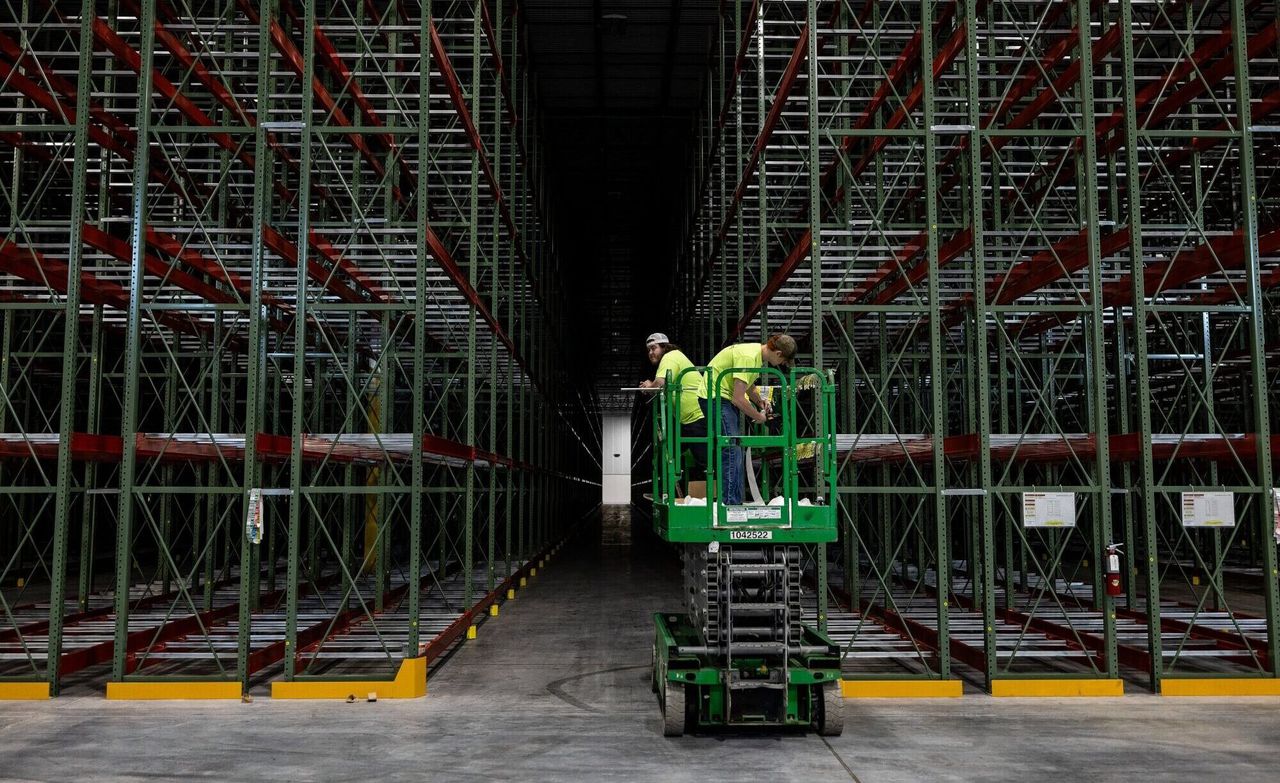Is Europe running out of steam now? In the world of economists, thinkers and policymakers thinking about the European economy, it is one Hot topic: Disappointing growth in Europe after the corona pandemic, especially compared to the US.
In the euro zone, GDP growth will be 0.8 percent this year, and next year, the European Commission recently forecast, it will rise to 1.4 percent. Compare that to US growth: 2.7 percent in 2024 and 1.9 percent in 2025, according to International Monetary Fund (IMF) projections.
European companies are more pessimistic than they have been in the US for some time. Surveys have been conducted among purchasing managers of companies Purchasing Managers Codes (PMIs) remained below 50 till March this year. It represents economic contraction. It ended recently. The industry, especially in Germany, is still negative.
Why do politicians and economists care about this? If the economy falters for a while, it’s not so catastrophic. In 2022, the situation was the other way around: the European economy grew faster than the American economy.
Huge US budget deficits in recent years are often cited to explain the growth gap between the US and Europe. When the government spends more money than it takes in, it pumps money into the economy and that drives GDP growth. The U.S. budget deficit will hit 6.5 percent of GDP this year, compared with a euro zone average of 2.9 percent. The question is how long the U.S. can maintain these deficits: Concerns are growing about the sustainability of U.S. public finances.
Another side note: GDP growth figures don’t tell the whole story. This means you can’t read income and wealth inequality or living standards from it.
Not enough prosperity
Still, there is growing concern among policymakers and experts that Europe’s lack of economic dynamism — compared to China and other emerging economies — could prove structural. This is a problem because in the long run Europe cannot generate enough prosperity to support big spending. And they’re coming: for conservation, energy transition, climate adaptation for an aging population that’s moving faster than America’s. Not to mention unexpected new shocks like epidemics.
European governments don’t have much money in their coffers. To deal with the corona crisis and the energy crisis, European governments have often used their buffers. The European Central Bank (ECB) recently noted that sovereign debt levels of European countries are generally higher than before the pandemic.
So European countries need more economic growth: then more money will flow into the treasury and national debts will become more bearable. Europe’s “fundamental” challenge, the International Monetary Fund said recently, is raising its “still grim medium-term growth forecast.”
How will you boost economic growth? The debate focuses on Europe’s competitiveness. In fact, it is the ability to capture a share of global economic growth – in times of fierce competition with emerging nations such as China, the US and India. Another recurring term in the debate is ‘productivity’: how much economic growth can be generated with the available resources (labour, capital, resources). Productivity in the US is higher than in Europe and growing faster.
In the debate about the European economy – which is also reflected in the European election campaign – the ideas that often arise compared to the US: what do they do better than us? You may always wonder if the American recipe is possible and desirable in Europe.
1. Attract more immigrants
First, a hot political issue: migration. Part of America’s economic growth in recent years has been due to significant immigration, US Federal Reserve Chairman Jerome Powell said recently during a panel discussion in Amsterdam. “People come in, get work permits, go to work and pay taxes and create economic activity,” Powell said. “There are millions.”
Immigration does not have the concept of an independent central bank, he hastened to say. “I’ll give you the economics of it.”
According to projections from statistical agencies in the US and EU, the US population is still It will grow up to 2080Perhaps that of the European Union will shrink in 2026. Two-thirds of US population growth came last year through immigration .
And, within Europe, the Netherlands projects an ‘American’ image in this area. This is where people live According to a forecast Statistics show that the Netherlands will continue to grow until at least 2070 – mainly through (labour) migration.
In the European election campaign, right-wing parties have been pushing for immigration restrictions. Economists find this cool. John Springford of the Center for European Reform Think Tank writes in an analysis: Less migrant workers means less tax revenue for governments. And that means Europeans will have to pay more taxes to pay for the costs of aging themselves (pensions, healthcare). The reservoir of Eastern European workers is running out, so Europe needs to attract people from around the world, he says. “Europe Must Choose: Multiculturalism or Stagnation.”
2. Working long hours
There is an alternative to attracting more immigrants: making working people work harder. Americans are often shocked by the generous vacations, many public holidays, and part-time arrangements that Europeans enjoy. The Dutch work an average of 1,400 hours a year, the French 1,500, the Germans 1,300 and the Americans 1,800, according to the OECD organization of rich industrialized nations.
The trend in Europe is to work even less. Since the pandemic, the work week has become shorter. The average number of hours worked per week in the EU (the middle of the data series) was still 37.5 in 2019. By early 2023, it was 36.5, according to the IMF. The fund talks about a “structural” downward trend.
Where does that decline come from? No one knows exactly. Many economists suspect that this is simply related to the preferences of Europeans. Those who can afford it prefer extra free time to extra money. Some countries, including the Netherlands, are experimenting with full-time bonuses to encourage people to work longer hours. The question is whether it will diminish Europeans’ love of the pastime.
This is having an effect, said Isabelle Schnabel, a member of the ECB Board of Directors. In February. To financially accommodate an aging population, productivity – output per hour – must increase in Europe.




GDP growth in the US this year will be 2.7 percent. In the Eurozone it was only 0.8 percent.
Photos: Justin Sullivan/Getty Images/AFP, David Ryder/Bloomberg, Samuel Coram/Bloomberg, Frederick J. Brown/AFP
3. Deepen the internal market
Technological advances and increasing efficiency are key drivers of productivity growth. You can increase productivity by spurring innovation and making markets work more efficiently. That is why there is now much talk of a new impetus for the European internal market, a system of laws and regulations that promote the free movement of goods, labor and capital within the EU.
The internal market works well in some areas, less so in others. For example, the European capital market is highly fragmented and underdeveloped. In practice, European companies have difficulty getting money, especially for risky investments. The US market for stocks, bonds and derivatives is large, deep and highly dynamic. It’s driving innovation on the other side of the Atlantic. Compared to their turnover between 2015 and 2022, European companies will spend half as much as US companies on research and development. According to a report by consulting firm McKinsey.
If EU countries combine their capital markets into a ‘Capital Markets Union’, European companies will have more access to capital. Former Italian Prime Minister Enrico Letta recently endorsed this In Report on the European Internal Market. But such a ‘capital markets union’ would require new EU legislation on, among other things, the pensions sector. More European integration as Eurosceptic parties make gains in next week’s European elections.
4. More subsidies to industry
When you think of the American economic model, you probably think of small government, free market capitalism. In practice, however, the US economy has always relied heavily on government spending on defense and space. The government had to bail out the banks (2008) and the car industry (2009). For some years now, it has been the most active role of government characterizing the American economy.
With his big industry policy, President Joe Biden has changed the playing field. He is offering billions in subsidies and tax breaks to attract the chip industry and green technology to America. And it seems to work: companies making major investment decisions often choose the US. For example, he wrote, the country is attracting new battery factories at Europe’s expense Researcher Ron Stoop recently published in an economics journal ESB.
French President Emmanuel Macron argued recently In a speech at the Sorbonne University For a large-scale European industrial policy, what Europe is already doing. As the EU has already relaxed state aid rules, member states can also liberally support tech companies. However, engaging in “subsidy competition” in response to industrial policy pursued by the US and China has major disadvantages, the IMF says. Direct subsidization of companies is expensive, undermines free competition and distributes these subsidies to others in favor of member states. In this way, according to the IMF, the efficiency brought about by the European internal market is undermined.
As it turns out, there is no panacea for increasing economic activity in Europe. Many US measures simply cannot be transferred to Europe – even if the European electorate heading to the polls next week wants them.

“Passionate analyst. Thinker. Devoted twitter evangelist. Wannabe music specialist.”






/s3/static.nrc.nl/wp-content/uploads/2024/05/28225631/data116286109-fded58.jpg)
More Stories
Cooperation between the US and China ensures more stable corporate finance – FM.nl
New US peace proposal for Gaza war ‘may be too smart for either side to say no’
Bitcoin weathers bankruptcy storm in US